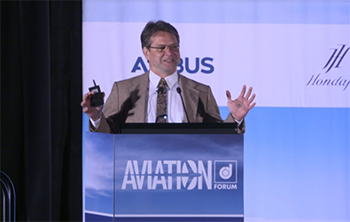Making Aerial Ride Sharing a Reality Written 9 June 2017
Speaker: Mark Moore, director of aviation, Uber
By Tom Risen, Aerospace America Staff Reporter (2017-2018)

City-dwellers spend hours in traffic, but the wave of companies building electric vertical takeoff and landing craft, or eVTOLs, could allow commuters to fly above gridlock, Mark Moore, the engineering director of aviation for Uber, said June 9 at the 2017 AIAA AVIATION Forum in Denver.
Prior to joining Uber in February, Moore worked at NASA’s Langley Research Center as the principal investigator for the X-57 aircraft being built to test new electric propulsion technology, which capped off his 32-year career with NASA. Moore is using his knowledge of the electric propulsion community to build the Uber Elevate ecosystem by partnering with electric charging companies and real estate firms to create infrastructure for landing, flying and charging eVTOLs.
Uber is not building its own aircraft, but its aerospace partners so far include Aurora Flight Sciences, Slovenia-based electric plane maker Pipistrel, Bell Helicopter, Brazil-based Embraer and general aviation manufacturer Mooney. Creating this ecosystem could make eVTOLs a more efficient, safer and less noisy option for broad use in an urban environment than helicopters, Moore said.
“Helicopters are simply not good enough,” he said, touting the potential for aerial ride sharing using eVTOLs that aim to be affordable enough for most consumers because electric power is more efficient. “Ten percent of millennials say they never want to own a car.”
Moore said Uber aims for aircraft provided by its partners to conduct the initial experimental flights for the Uber Elevate aerial ride-sharing program in 2020 in Dallas and Dubai and expects to begin offering aerial ride sharing to consumers in 2023 in those cities.
Obstacles to aerial taxi services include not only gaining public acceptance with low noise and affordability, but also proving their safety to the FAA. Limits on how far apart aircraft can fly between each other in Class B airspace near airport traffic areas could make it difficult to fly numerous air taxis in a city if that regulation is not addressed.
Uber is working with the FAA on how to prove the safety of eVTOLs that could launch and charge from “vertiports,” including at unused helicopter pads, he said. If regulators certify the eVTOL ride-sharing ecosystem, it could set the stage for “clean electricity to be the dominant energy for the future,” he said.
